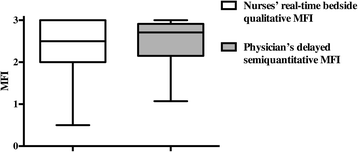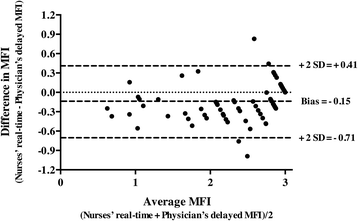Qualitative real-time analysis by nurses of sublingual microcirculation in intensive care unit: the MICRONURSE study
- PMID: 26542952
- PMCID: PMC4635966
- DOI: 10.1186/s13054-015-1106-3
Qualitative real-time analysis by nurses of sublingual microcirculation in intensive care unit: the MICRONURSE study
Abstract
Introduction: We aimed to determine i) the feasibility of nurses taking bedside measurements of microcirculatory parameters in real time in intensive care patients; and ii) whether such measurements would be comparable to those obtained by the classical delayed semi quantitative analysis made by a physician.
Methods: This prospective observational study was conducted in a university hospital and was approved by our local Institutional Review Board (IRB 00006477). After ICU admission and study inclusion, a set of measurements of macrocirculatory and microcirculatory parameters was taken by the nurse in charge of the patient every 4 h within the first 12 h after admission and before and after every hemodynamic therapeutic intervention. Seventy-four sublingual microvascular measurements were performed with incident dark field illumination (IDF) microscopy in 20 mechanically ventilated patients hospitalized in the ICU.
Results: There were no significant differences between the microvascular flow index (MFI) taken in real time by the nurses and the delayed evaluation by the physician. In fact, the nurses' real-time measurement of MFI demonstrated good agreement with the physician's delayed measurement. The mean difference between the two MFIs was -0.15, SD = 0.28. The nurses' real-time MFI assessment showed 97 % sensitivity (95 % CI: 84-99 %) and 95 % specificity (95 % CI: 84-99 %) at detecting a MFI <2.5 obtained by a physician upon delayed semiquantitative measurement. Concerning the density, 81 % of the paramedical qualitative density measurements corresponded with the automatized total vessel density (TVD) measurements. The nurses' real-time TVD assessment showed 77 % sensitivity (95 % CI: 46-95 %) and 100 % specificity (95 % CI: 89-100 %) at detecting a TVD <8 mm/mm(2).
Conclusion: A real-time qualitative bedside evaluation of MFI by nurses showed good agreement with the conventional delayed analysis by physicians. The bedside evaluations of MFI and TVD were highly sensitive and specific for detecting impaired microvascular flow and low capillary density. These results suggest that this real-time technique could become part of ICU nurse routine surveillance and be implemented in algorithms for hemodynamic resuscitation in future clinical trials and regular practice. These results are an essential step to demonstrate whether these real-time measurements have a clinical impact in the management of ICU patients.
Figures



Similar articles
-
Bedside analysis of the sublingual microvascular glycocalyx in the emergency room and intensive care unit - the GlycoNurse study.Scand J Trauma Resusc Emerg Med. 2018 Feb 14;26(1):16. doi: 10.1186/s13049-018-0483-4. Scand J Trauma Resusc Emerg Med. 2018. PMID: 29444696 Free PMC article.
-
[The clinical significance of determining the severity and prognosis by monitoring the changes in sublingual microcirculation in patients with severe sepsis].Zhongguo Wei Zhong Bing Ji Jiu Yi Xue. 2012 Mar;24(3):158-61. Zhongguo Wei Zhong Bing Ji Jiu Yi Xue. 2012. PMID: 22401160 Chinese.
-
Point-of-care assessment of microvascular blood flow in critically ill patients.Intensive Care Med. 2009 Oct;35(10):1761-6. doi: 10.1007/s00134-009-1517-1. Epub 2009 Jun 24. Intensive Care Med. 2009. PMID: 19554307
-
Prognostic Value of Sublingual Microcirculation in Sepsis: A Systematic Review and Meta-analysis.J Intensive Care Med. 2024 Dec;39(12):1221-1230. doi: 10.1177/08850666241253800. Epub 2024 May 15. J Intensive Care Med. 2024. PMID: 38748542
-
Is microcirculatory assessment ready for regular use in clinical practice?Curr Opin Crit Care. 2019 Jun;25(3):280-284. doi: 10.1097/MCC.0000000000000605. Curr Opin Crit Care. 2019. PMID: 31022089 Review.
Cited by
-
Assessment of sublingual microcirculation in critically ill patients: consensus and debate.Ann Transl Med. 2020 Jun;8(12):793. doi: 10.21037/atm.2020.03.222. Ann Transl Med. 2020. PMID: 32647718 Free PMC article. Review.
-
Real-time point of care microcirculatory assessment of shock: design, rationale and application of the point of care microcirculation (POEM) tool.Crit Care. 2016 Sep 30;20(1):310. doi: 10.1186/s13054-016-1492-1. Crit Care. 2016. PMID: 27716373 Free PMC article.
-
Venous-to-arterial CO2 differences and the quest for bedside point-of-care monitoring to assess the microcirculation during shock.Ann Transl Med. 2016 Jan;4(2):37. doi: 10.3978/j.issn.2305-5839.2015.12.61. Ann Transl Med. 2016. PMID: 26889490 Free PMC article.
-
Bedside analysis of the sublingual microvascular glycocalyx in the emergency room and intensive care unit - the GlycoNurse study.Scand J Trauma Resusc Emerg Med. 2018 Feb 14;26(1):16. doi: 10.1186/s13049-018-0483-4. Scand J Trauma Resusc Emerg Med. 2018. PMID: 29444696 Free PMC article.
-
Microcirculation during surgery.Anesth Pain Med (Seoul). 2022 Jan;17(1):24-34. doi: 10.17085/apm.22127. Epub 2022 Jan 21. Anesth Pain Med (Seoul). 2022. PMID: 35139609 Free PMC article. Review.
References
-
- Trzeciak S, McCoy JV, Phillip Dellinger R, Arnold RC, Rizzuto M, Abate NL, et al. Early increases in microcirculatory perfusion during protocol-directed resuscitation are associated with reduced multi-organ failure at 24 h in patients with sepsis. Intensive Care Med. 2008;34:2210–7. doi: 10.1007/s00134-008-1193-6. - DOI - PMC - PubMed
Publication types
MeSH terms
LinkOut - more resources
Full Text Sources
Other Literature Sources
Medical

